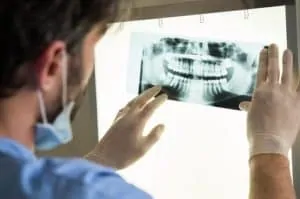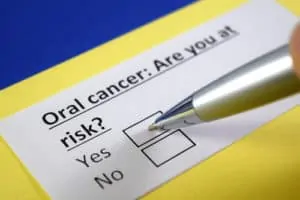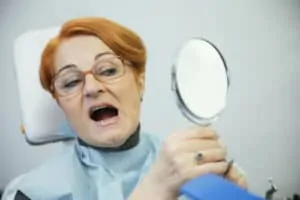Preventive Dentistry

What We’re Looking for
While we can tell a lot about your oral health through our thorough exams and cleanings, there are just some things the human eye can’t see. For these diseases or problems, we turn to x-rays of your teeth and jaw. Taking pictures of the inner workings of your teeth can help us diagnose:
- Decay that’s not yet surfaced
- Bone loss associated with gum disease
- Impacted wisdom teeth
- Damaged bone cause by an infection
- Abscesses or other root problems
Taking x-rays allows your dentist in Sparks to see any issues that may not yet have signs or symptoms, making them easier to treat before they lead to pain or more complicated treatments.
The Different Types of Dental X-Rays
There are several different types of x-rays that your dental team may use to examine various parts of your oral anatomy. Each type of x-ray can help show different things. Some of the most common x-rays include:
- Bitewing X-rays. Bitewing x-rays are the ones that can show cavities or areas of decay that may not yet be visible, or are lurking in hard-to-see areas such as in between teeth or fillings. These x-rays may also show bone density health and any deterioration caused by gum disease.
- Periapical X-rays. Just like bitewing x-rays, periapical x-rays are pretty common. You probably have had them taken and may not have even known it. These x-rays show images of the entire tooth, including the roots. The images allow your dentist to look at each tooth individually to make sure each one is structurally sound and bone levels are healthy and strong. Periapical x-rays can also help catch cysts and abscesses.
- Panoramic X-rays. Panoramic x-rays are used for the most complete view of your entire mouth. The images don’t only show all your teeth, but also your sinuses, jaw joints, and jaw bones. These photos can help determine if wisdom teeth are impacted and can even help diagnose a tumor.
Dental x-rays are an important part of your preventive dental care and should be taken at least once a year, but sometimes we may recommend getting them taken at every bi-annual visit. The advancements in technology, along with the careful measures we take in our Sparks dental office make dental x-rays incredibly safe and have low radiation emissions. If you’re concerned about dental x-rays, we welcome you to talk to any one of our team members.

Know The Risks
It’s important to note that anyone can develop oral cancer whether they have or engage in factors that increase their risk or not. Some of the risks are unavoidable, but many can be controlled through making smart lifestyle choices. Some factors that increase the risk of oral cancer include:
- Tobacco Use: Smoking cigarettes, cigars, or using smokeless tobacco greatly increases your risk of oral cancer. Statistics show that 80% of oral cancer diagnoses are in tobacco users.
- Drinking Alcohol: Consuming alcohol regularly can also put you at greater risk. Nearly 70% of those diagnosed with oral cancer are heavy drinkers.
- Drinking & Smoking: Since both tobacco use and drinking large amounts of alcohol increases the likelihood of getting oral cancer, if you do both, your chance for oral cancer can be as high as 100%.
- Gender: Men are two times more likely to develop oral cancer than women. While this risk factor can’t be changed, men can reduce their risk by not drinking or smoking.
- Age: Our chances of getting oral cancer increases as we age. The average age of diagnosis is 62, and the majority of oral cancer patients are at least 55.
- UV Rays: Skin cancer isn’t the only thing that can happen from too much unprotected sun exposure. Oral cancer is also higher in those who spend a lot of time in the sun without wearing sunscreen.
Recognize The Symptoms
Being able to identify the signs and symptoms of oral cancer early increases the chance of survival. Oral cancer treatment is often successful in the earlier stages, so the sooner you see your dentist in Sparks if you suspect anything, the better. The most common signs include:
- Chronic bad breath
- Sores that won’t heal
- A lump on the cheek
- Difficulty swallowing
- Changes in your voice
During your regular dental cleanings and exams, your hygienist and dentist will monitor your mouth for any abnormalities and can use high-tech equipment that can show what the human eye can’t see. This is just another reason maintaining your bi-annual dental appointments is so important to your overall health.
If it’s been longer than six months since your last visit, call our dental office in Sparks to schedule an appointment today. You never know, one visit could save your life.

Gum Disease
Gum disease is a serious infection that requires a proper diagnosis and early intervention to treat. It’s typically caused by a buildup of plaque that’s not removed through proper brushing and flossing at home. When left on the teeth too long, this plaque builds and transforms into hard tartar. This tartar is impossible to remove on your own and requires a professional dental cleaning. However, if the tartar is not removed, the bacteria within it can move into the gum tissue and cause an infection. This infection can easily progress into gingivitis or periodontitis and may cause tooth loss. But the worries don’t stop in your mouth. In fact, research shows that gum disease has been linked to heart disease.
Heart Disease
Untreated gum disease leaves the infection free to do whatever it wants, including traveling into other areas such as the bloodstream. If this happens, your body responds by producing too much C-reactive protein (CRP). Higher than normal levels of CRP can lead to serious conditions such as:
- Inflamed arteries
- Blood clots
- Heart attacks
- Strokes
Recognize the Signs of Gum Disease
Diagnosing gum disease and beginning treatment is key to protecting your mouth and your overall health. To do that, you need to be able to recognize the common signs of gum disease including:
- Bleeding when brushing or flossing
- Puffy, tender gums
- Bad breath
- Loose teeth
If you notice any of the signs of gum disease, call your dentist in Sparks to schedule an appointment.
Besides brushing and flossing every day at home, the best way you can avoid gum disease and protect your heart is to maintain regular dental visits at least twice a year. These appointments can go a long way in keeping you healthy. If it’s time for your bi-annual dental cleaning, give our Sparks dental office a call today.

Teeth with Deep Grooves
Many people naturally have teeth with many deep grooves. Most commonly found in the back molars, these grooves can make it difficult to fully remove food particles and bacteria. This makes them the perfect place for bacteria to bury in and create tooth decay.
Genetics
Our genes play a large role in our overall health, including the health of our mouths. Some genes make certain people more susceptible to having large amounts of mouth bacteria while others can be responsible for brittle teeth. Both of these concerns are likely to increase the person’s risk of cavities.
Certain Medications
Dry mouth is a common side effect of many medications and even some cancer treatments. While this may seem like no big deal or simply an unpleasant feeling, dry mouth can be dangerous to oral health. When someone suffers from dry mouth, they aren’t producing enough saliva to rinse away bacteria or neutralize acid. This allows the bacteria to hang around and decay teeth and the acid to damage protective enamel. Without enamel, teeth are at even more risk for decay.
Aging
Just like the rest of our bodies, our oral health changes as we get older. Our teeth may become weaker, our mouths drier, and our gums may even recede. All of these things allow bacteria to attack our mouths and teeth, increasing the likelihood of cavities.
Dental Restorations
Dental restorations such as fillings are designed to fix problems such as cavities. However, if done improperly they can have an adverse effect. Loose fillings or ones that are too large can allow bacteria to get under them. If this happens, the decay can continue to affect the tooth. Most likely, the filling will need to be replaced.
Grinding Your Teeth
Tooth grinding is common among the U.S. population. Whether done during sleep or as a response to stress, it can not only damage teeth, it can also make it easier for cavities to form. The repeated tooth-on-tooth grinding wears away enamel. As we learned earlier, less enamel means more risk for cavities.
We recommend doing your best to avoid the controllable lifestyle choices above that contribute to dental decay. And while you may not be able to totally avoid or change the others, our dental office in Sparks can help reduce the effect they have on your teeth. We welcome you to schedule an appointment so we can work together to prevent cavities or other oral health problems.

What Exactly is Charcoal Toothpaste?
Before we launch into whether or not charcoal toothpaste can really whiten your smile, let’s look into what the stuff actually is. Charcoal toothpaste uses something called activated charcoal, which is much different than the charcoal you’d use to grill a burger. Activated charcoal is a form of carbon that’s been treated in order to make it incredibly porous. Since the porous nature makes activated charcoal really great at absorption, the thought is that it can pull stains, tartar, and bacteria away from teeth.
Is Charcoal Toothpaste Safe?
The short answer is yes, charcoal toothpaste is safe for the human body. Even though the modern age of the world wide web may have popularized the use of it, its usage has a rich history dating way back to the days of the ancient Romans. In fact, a powder form of charcoal was a pretty common ingredient in their toothpastes. Besides its dental usage, activated charcoal was, and still sometimes is, used to treat people who have been poisoned.
So, Does it Whiten Teeth?
Charcoal toothpaste has been effective at removing surface stains on teeth which may help a smile appear whiter. However, using it doesn’t come without risks. Even though charcoal toothpaste is porous, it’s also fairly abrasive. According to the American Dental Association (ADA), charcoal toothpaste is too abrasive to be used regularly and may result in damage. Using an abrasive toothpaste can wear away the protective layer of enamel, making teeth not only more exposed to the dangers of bacteria, but also creating a dingy, discolored appearance.
Other Ways to Whiten Your Teeth
If you’ve tried charcoal toothpaste and didn’t see the results you were hoping for, or you’re not quite on board with its claims, there are still other safe and effective ways you can whiten your teeth.
- Try a whitening toothpaste that has the ADA Seal of Acceptance
- Schedule a professional smile whitening with your dentist in Sparks
- Consider dental veneers to cover up any discoloration or imperfections
As always, our dental office in Sparks is happy to answer any questions you may have about the best way to whiten your teeth. Give us a call today to schedule an appointment!

Brush Up on Your Brushing
Brushing our teeth has been a habit since we were young. And when we do something that’s so simple for so long, it’s easy to skimp on doing a thorough job. Start brushing with a purpose, paying attention that you’re cleaning each surface of every tooth using gentle circles. Two minutes of proper brushing twice a day can do wonders for fighting bad breath.
Drink Plenty of Water
Being properly hydrated isn’t only great for your body, it’s incredibly beneficial for your mouth too. A hydrated mouth helps rid your mouth of bad breath germs and bacteria by washing it away.
Quit Smoking
Immediately following a cigarette, bad breath is guaranteed. However, this ‘smoker’s breath’ can last hours after smoking. The lungs and the throat can hold on to stinky smoke particles, releasing them into the air with every breath. Quitting isn’t only a great way to get fresher breath, it’s best for your overall health.
See Your Dentist
Regular visits to your Sparks dentist are they best way to combat bad breath. Professional dental cleanings remove stuck on tartar and bacteria that can’t be touched with at-home brushing. You should see your dentist twice a year, perhaps more if you need more thorough, deep cleanings.
When Bad Breath Gets Serious
You can try every trick in the book to alleviate bad breath, and even then it may not disappear. If this is the case, it may be a sign of something more. Bad breath could be a symptom of:
- Gum Disease
- Pneumonia
- Sinus Infection
- Diabetes
- Liver or Kidney Problems
If you’ve been living with the embarrassment of bad breath and are ready to fix it, start by scheduling an appointment at our Sparks dental office. We’ll work with you to determine its cause and talk about the best way to get you back to freshness.

- Wash Your Hands Often
Using warm water and soap, scrub your hands before preparing food, after eating or using the restroom, and after shaking hands. If soap and water are unavailable use an alcohol-based sanitizer.
- Keep Your Hands Away From Your Face
Germs spread easily through the eyes, nose, and mouth. If your hands get in contact with flu germs and you rub your eye, itch your nose, or bite your fingernail, it’s almost a guarantee that you’ll get sick.
- Drink Plenty of Water
Your body functions optimally if it’s hydrated. This includes its ability to fight off germs. Not to mention, a well hydrated mouth is a healthy mouth, and that’s sure to make your dentist in Sparks happy.
- Eat a Well Balanced Diet
Fueling your body with fruits, veggies, whole grains, and proteins is crucial in helping your body stay healthy. Proteins, in fact, have been proven to support the immune system so make sure you’re getting your fair share.
- Clean Your Home and Your Office
Sanitize the areas you or others use most. Think about the items that get touched often like doorknobs, toilets, elevator buttons, or your computer mouse. A good rule of thumb to follow is to clean it even it doesn’t look dirty.
- Take Care of Your Toothbrush
Toothbrushes can hold a lot of bacteria and if not taken care of properly could make you sick. Make sure you rinse the bristles thoroughly after each use, store family members’ brushes far away from each other, and consider sterilizing them once a week in hot water.
- Avoid People Who Are Sick
Although this seems obvious, it’s not always simple. If a co-worker comes to the office sniffling and sneezing, it’s difficult to avoid them and everything they touch. Try to communicate via email instead of face-to-face meetings, carry alcohol-based hand sanitizer with you, and again, always wash your hands and avoid touching your face.
If you do happen to get sick, try your best to stay home to help prevent the illness from spreading to others. Our dental office in Sparks also encourages you to find sugar-free medications so as you’re working on feeling better, you’re not doing damage to your oral health.

Best Choices
- Chocolate Bars – You can’t go wrong with some pure, delicious chocolate. Whether you choose a candy bar or perhaps a Hershey’s Kiss, chocolate dissolves quickly and is safe for braces. If you’re lucky enough to score a full-size candy bar, we encourage you to cut it up into smaller pieces to reduce the risk of damaging the braces on your front teeth as you bite into it.
- Peanut Butter Cups – Another scrumptious yet safe option for braces are peanut butter cups. Their smooth consistency makes chewing very easy with really no concern of breaking a bracket or wire.
- Milky Ways – Although these candy bars contain caramel (more on that in a bit), Milky Ways are still soft enough for braces wearers to enjoy.
Important Note: All of these options are safe as long as they’re not frozen. Frozen chocolate bars and peanut butter cups make the texture too hard to bite and chew safely.
Worst Choices
- Hard Candy – Candy that falls under this category can be both all right for braces and potentially damaging. Hard candies that allow you to suck on them over time, reducing their size and making them less dangerous for braces, may be ok to enjoy. However, it increases the time your teeth are exposed to the sugar which may put you at greater risk for decay.
- Gooey Gum – When you first got your braces you were probably told to avoid gum. That rule doesn’t change during Halloween. Chewing gum can bend your wires, and that’s particularly concerning. When a wire is placed by your doctor, it’s put on in such a way that gently moves your teeth into the desired position. However, if the wire bends, your teeth tend to follow the direction of the wire instead of its original path. This can actually prolong treatment.
- Sticky Sweets – Things like caramels, gummies, taffy, and similar candies are almost sure to cause some trouble. Sticky sweets and their tacky consistency not only tend to bend wires, they’re also bad for your teeth in general. The stickiness allows the sugars to stay attached to teeth longer, again increasing your risk for decay.
Important Note: When in doubt, if it’s sticky, hard, or super chewy, it’s best to choose another option.
In order to keep your braces in tip-top shape and to avoid any broken brackets, bent wires, or other complications, it’s wise to listen to your dentist in Sparks about which foods are safe for braces. Halloween candy is no exception. Following the guide of braces-friendly candy can protect your braces and help you avoid an emergency dental appointment.

Taking Smoke Breaks
Smoking, as well as using smokeless tobacco, can lead to very serious health problems. Some of which can be life threatening. These habits can also contribute to several oral health concerns ranging from minor problems like tooth discoloration and bad breath to very serious issues including gum disease, tooth loss, and oral cancer. Smoking can be a very difficult habit to break, but instead of stepping outside to light up, consider chewing sugarless gum and talk with your doctor about ways to quit.
Not Brushing Your Teeth
We believe that everyone should keep a toothbrush and toothpaste in their desk drawer for use in between snacking and lunchtime. When we eat, the bacteria that live in our mouths begin to feed on the tiny foodstuffs left behind. As a result, these bacteria release acid. When the acid isn’t rinsed away by either saliva or through a proper brushing, it’s left to eat away at enamel. Enamel is designed to protect teeth from decay and once it’s gone, we’re left at increased risk for cavities.
Chewing on Pens
Chewing on the tips of pens or pencils is incredibly common among office employees and even children in school. We typically put pens in our mouths during times of intense thought, boredom, or stress. Sometimes we aren’t even aware we’re doing it. But nibbling on these tough writing utensils can cause some serious damage. Biting on pens or pencils has a tendency to lead to cracked, chipped, or broken teeth that will require restorative dentistry treatment from your Sparks dentist to fix.
Not Using the Right Tools for the Job
Whether you’re trying to open packaging that may be sealed a bit too well, or you need to rip a piece of tape off the roll, you should always use tools meant for these purposes like scissors, not your teeth. Teeth are meant to help us chew food to make it easy to swallow and digest. They aren’t designed to grab and rip or cut. Using teeth as tools can result in damage like cracked or broken teeth.
Recognizing the habits that can lead to tooth damage can help us realize when we’re putting our smiles at risk. If you find yourself doing any of the habits, our Sparks dental office is here to help you stop or fix any problems you may have as a result.

What Are Probiotics?
Talks about probiotics have been increasingly popular throughout the past couple of years. But what are probiotics and why are they good for you? Simply, probiotics are live microorganisms that help support our bodies. These microorganisms are usually bacteria, but not the bad bacteria that we normally think about and that make us sick. The bacteria we refer to when talking about probiotics are the good bacteria that help us stay healthy.
Different Probiotics Treat Different Things
You may remember some yogurt companies in particular mentioning probiotics in their advertisements. These probiotics specifically help with digestion and support gut health by keeping enough good bacteria around to fight off the bad bacteria off. There are other types of probiotics around that tend to help different areas of the body. In this case, we’re referring to oral probiotics.
Oral probiotics are ones that are being researched to study their effects on oral health. And there may be some exciting news in the future. Initial studies support the idea that there may be a positive correlation between specific types of probiotics and reducing the risk of gum disease, plaque, and bad breath.
Let’s Talk About Bifidobacterium & Lactobacillus
Don’t worry about how to pronounce them, let’s just focus on why we’re taking a closer look at them. Bifidobacterium and Lactobacillus are strains of probiotics and are the two that are mainly used in probiotic research in relation to oral health. Found naturally in both the bodies and mouths of mammals, Bifidobacterium and Lactobacillus have been studied closely to see if there was a connection between increasing the amount of them in test subjects and healthier mouths. While the amount of research we currently have is limited, and the evidence is not yet conclusive, there have been cases where Bifidobacterium and Lactobacillus have helped in the treatment of periodontal disease and halitosis, and has seemed to reduce the risk of cavities.
This is exciting news for the dental community. But while we’re waiting on researchers to continue studying the possible connection, we don’t recommend simply starting yourself on a probiotics routine before discussing it with your medical team, including your dentist in Sparks.
